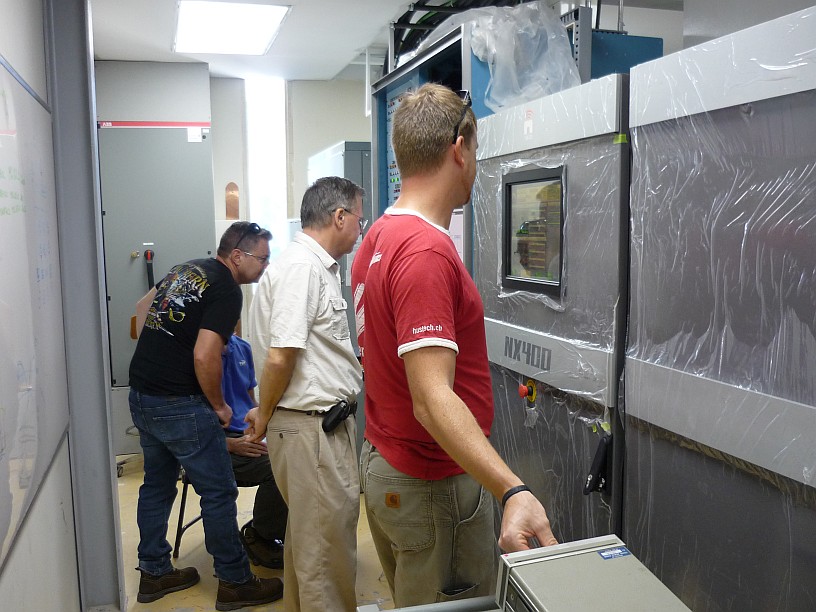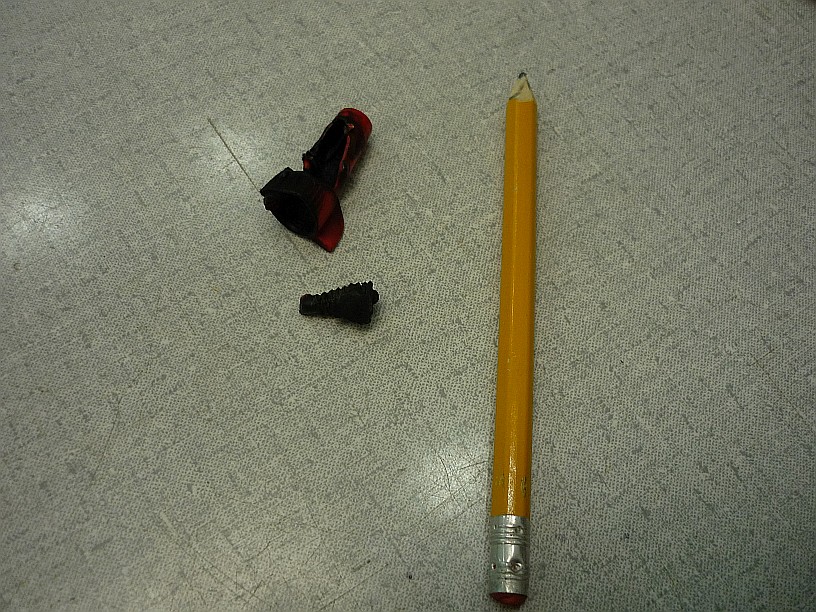The location for devotions returned to the site this morning and I caught a ride with Jason. For finding the missing wire connection yesterday, I was presented with a surprisze (100ml bottle of maple syrup straight from New Brunswick, Canada!) by Steve Shantz. Jonas also got a ‘prize’ just like mine for his work on the transmitter.
Daryl, Jonas and Dave began testing the Caribbean pattern which is rated at 350kw maximum compared to the north and south pattern’s 440kw rating. They were getting some ‘shutbacks’ as they approached 300kw with tone modulation. They found and corrected some minor arcing problems at the antenna tuning hut for tower 3–the main tower used for the Caribbean pattern. The bottom hinge on the safety gate just inside the door to the tuning hut was found to be glowing red hot. They ended up putting a ground strap across the hinge and tying it to ground. It is amazing what can occur at such high power levels!

Steve Shantz, Daryl (behind Steve), Dave and Jonas using tone to test the transmitter
They began to do a lot of readings on the transmitter and setting up of the transmitter computer menus. While they did this, I tried to make myself useful on other projects.
After the high power testing yesterday, Daryl and Jonas noticed that the temperature in the power room had increased to over 115F. They decided to have a small air conditioner installed. The wiring for the air conditioner had been put in already, but a 220-volt 2-pole circuit breaker needed to be installed in the 800 distribution panel. Because the circuit breakers in this panel are all the bolt-in type, power to this panel had to be shut down. [I’m guessing most electricians have a special tool to do this without shutting down power] I thought of making such a tool, but decided that would take much longer than the minute, or two, of ‘power off’ time required to bolt the breaker into place. Also, the transmitter testing could continue, since the transmitter is connected to the 380 volt panel and the 220 volt auxiliary equipment needed is powered through the UPS. The air conditioner people doing the work can do a split unit installation in around one hour. By the time they were ready to test the unit, i had already connected the power to the split units and the 220 volt breaker was ready to be switched on.
One of the two air handlers for cooling the transmitter was tripping its breaker. Since this is a fully redundant system, the second air handler was put into service. Each air handler uses a 10hp motor to turn its blower. The faulty motor would hum, but not turn, upon applying power. I suspected that it was ‘single-phasing’, meaning one phase was not connected. After checking voltages at the motor starter and finding one phase with normal voltage and the other two with reduced voltage, I decided to check the connections at the motor. When I opened its electrical box cover, everything inside was covered with black soot. The soot could be rubbed off two of the three connections, but it was obvious that the third connection had a problem. The ‘wire nut’ used to make the connection was melted. I suspect that one of the two wires had not been fully inserted into the ‘wire nut’ when it was screwed on. I cleaned up the burned wires, reconnected them and this air handler has now been returned to service.

The ‘wire nut’ that was found at the faulty air handler’s motor.
While talking to the engineers today, I asked what power level the people at the dedication would expect to see on the transmitter’s computer screen. Of course, they would want to see full power–440 KW! TWR Bonaire will normally use a type of modulation called AMC (Amplitude Modulation Companding) to save on electric costs without losing listeners. AMC operation will show varying instantaneous power levels on the screen, depending on the level of modulation. To show 440 KW continuously, will require the use of standard AM operation. This requires more power input and will test the limits of WEB’s (the power company’s) equipment. With normal programming at 440 KW, we should be just within the WEB’s limit. I asked about a clamp-on ammeter to measure the 380 volt line current, but no one knew of one that large enough. At the end of the day, Daryl came carrying a 1,000 amp clamp-on meter. Its calibration had last been checked in 1983. We were able to verify that it was still working properly when measuring current in the main cables while the transmitter was operating at 440 KW (no modulation). We are now confident that we can do testing tomorrow with modulation, and ‘push the limits’ without exceeding the limits of WEB’s 630kva transformer.
Jonas informed us before leaving the site, that WEB will be out in the morning to increase the voltage from their transformer. This means we will have to also change the taps on the transmitter transformer. I have been advocating for this to lower the current (and losses) in the power cables and breaker between the WEB transformer and the transmitter transformer. Only the transmitter uses this 380 volt source, and since the transmitter transformer has taps going up to 440 volts, why not take advantage of reducing loss by using higher voltage and lower currents to provide the same amount of power?!
I rode home with Daryl this evening arriving around 6pm. After supper of leftover spare ribs and baked spaghetti [we still have leftovers of the latter!] and salad, I walked over to Dave’s house to pick up some 220v LED indicator lights to install in the emergency stop button boxes to show that they are functional.
We also forgot to bring the charger for our camera battery with us to Bonaire and Dave thought he might have a cable that might fit the DC input for our camera. Unfortunately, no such luck. Dave previously brought in the charger for a Panasonic Lumix, which is the same brand as ours. It was obviously not the same model, because the battery pack sizes and contact placements are ever so slightly different. Kevin said he will bring his camera chargers in tomorrow. Hopefully one of those will work. If not, we will try to rig up a way to charge it with one of the site’s adjustable power supplies. The major challenge is making, and maintaining, contact with the tiny ‘pads’ on the edge of the battery pack. Tried earlier today and was not successful, but I have an another idea!
It looks like we might finally be able to get 8 hours of sleep tonight, for a change!




















